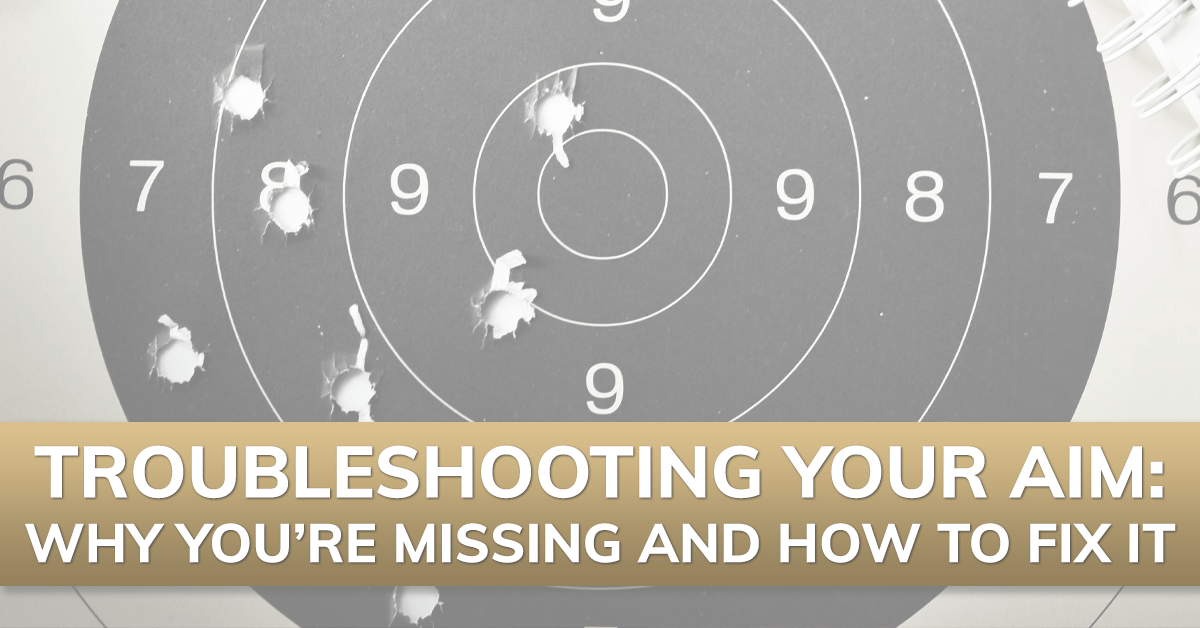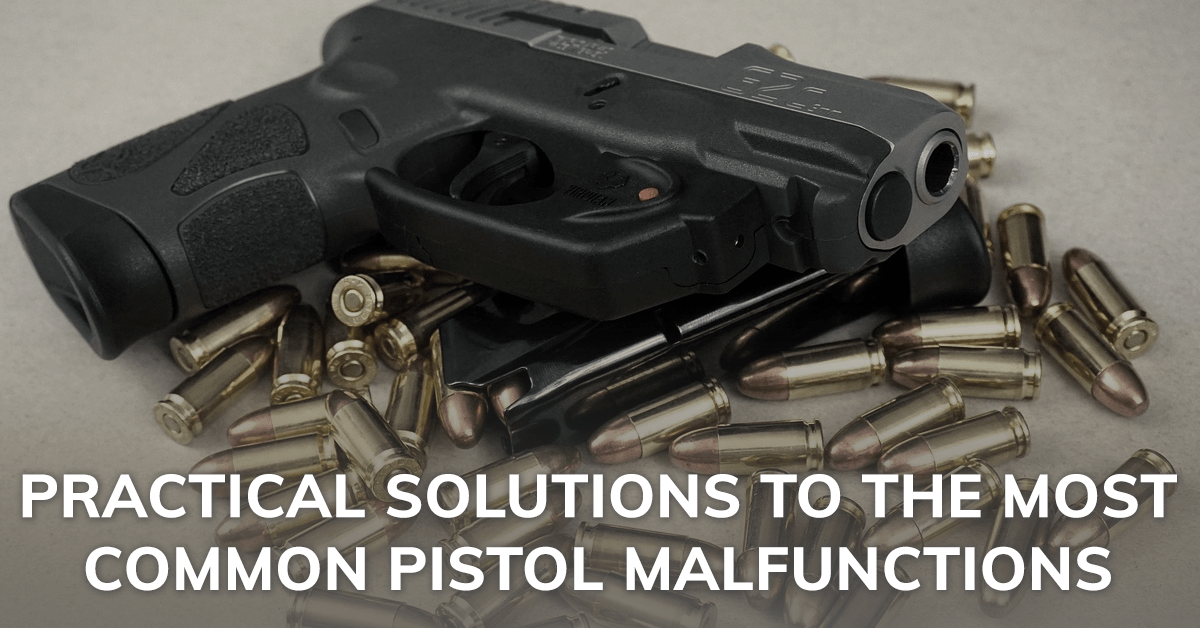Your Cart is Empty
Orders Over $100 Ship FREE (USA)!
Orders Over $100 Ship FREE (USA)!
CONCEALED CARRY
(Apparel with holster pockets or concealed-carry features)
(Apparel with holster pockets or concealed-carry features)
PARTS & GEAR
RANGE STYLE
Gift shopping & not sure about size or style? Give a gift card instead!
Gift shopping & not sure about size or style? Give a gift card instead!
GIFT IDEAS
The entire site is full of products that make great gifts, so browse all of our collections! Still not sure? Give a gift card!
The entire site is full of products that make great gifts, so browse all of our collections! Still not sure? Give a gift card!
EXPLORE
How to Manage Handgun Malfunctions
4 min read
It is important to understand and practice the ability to recover from a malfunction in order to be an effective shooter, whether you are shooting an action pistol match or in a self-defense situation. In most cases, these malfunctions occur in a semi-automatic handgun, but some are true for both the semi-auto and a revolver. Anytime you deal with a mechanical object, such as a handgun, there may be malfunctions from time to time. With handguns, those malfunctions may occur due to ammunition issues or mechanical issues.
Ammunition Malfunctions
Ammunition malfunctions are relatively rare but they do happen. There are three basic malfunctions that can be attributed to ammunition specifically: the misfire, the hangfire, and the squib load.
• Misfire - If you pull the trigger and there is no bang, this is considered a misfire. There could be various reasons for this to occur such as a bad primer or the powder in the cartridge has been compromised.
• Hangfire - In the case of a hangfire, the first indication that something is wrong is the same as a misfire. You have pulled the trigger and nothing has happened. However, with a hangfire, there just may be a delay between when you pulled the trigger and when the round actually goes off. Hangfires are extremely rare.
• Squib load - With a squib load, the cartridge has insufficient powder to fully propel the bullet to the target. Squib loads often make a distinctive sound, like a “poof” that is different than a normally functioning cartridge when fired. Often with a squib, the bullet gets stuck in the barrel of the firearm. A good way to determine if this has happened is with the use of a bore flashlight. You can shine the light from the feed ramp side of the chamber and if no light is seen coming through, the bullet is wedged in the barrel and must be pushed out with a cleaning rod.
Firearm Malfunctions
Not all malfunctions can be attributed to the ammunition. In some cases, the handgun itself is experiencing a problem:
 Failure to Extract – This happens when the extractor fails to grab the spent casing from the chamber as the slide moves to the rear. When this happens, a double feed is the usual result because there will be no place for the next round to go since the chamber is essentially blocked by the spent casing.
Failure to Extract – This happens when the extractor fails to grab the spent casing from the chamber as the slide moves to the rear. When this happens, a double feed is the usual result because there will be no place for the next round to go since the chamber is essentially blocked by the spent casing.
 Failure to Feed – Sometimes as the cartridge is pushed out of the magazine into the chamber it will exit the magazine at a slight angle and catch on the chamber, rather than entering it. The slide is unable to continue forward as it should because the cartridge is in the way. The result is that the slide is not fully forward as it should be.
Failure to Feed – Sometimes as the cartridge is pushed out of the magazine into the chamber it will exit the magazine at a slight angle and catch on the chamber, rather than entering it. The slide is unable to continue forward as it should because the cartridge is in the way. The result is that the slide is not fully forward as it should be.
Failure to Eject – When a cartridge fails to fully leave the ejection port before the slide returns to position, it can result in a stovepipe. This malfunction was so named because the cartridge usually gets caught in the vertical position as the slide cycles, resembling a little stovepipe sticking up out of the gun. This issue can be due to the shooter limp-wristing when shooting.
Recovering From a Malfunction
A training goal should be to overcome a malfunction as quickly as possible and resume shooting. But safety should always be a priority. If you are a beginning shooter and do not yet feel comfortable fixing your own malfunction, alert the Range Safety Officer (RSO) to the fact that a malfunction has occurred and let them help you. Keep the handgun pointed downrange and raise your support hand to get the attention of the RSO for their assistance.
You may have heard Tap-Rack-Bang as slang for the way to recover from a malfunction. Tap or smack the bottom of the magazine to make sure it is seated properly, rack the slide to eject the cartridge that may be causing the jam, which chambers a new round, put sights on target and press the trigger to keep shooting. This does not always work, however, and should never be the solution for the suspected squib load.
If the Tap-Rack-Bang process does not correct the problem, it is time to take a closer look at fixing the problem. In this case, remove the magazine. In the case of a double feed, a little strength may be required to get the magazine to budge. Once the magazine is clear, rack the slide to fully clear the jam, reinsert the magazine and continue shooting.
Malfunctions can be a little intimidating, especially for a new shooter. Just remember to follow the four safety rules, especially keep the muzzle pointing downrange in a safe direction while recovering from or troubleshooting a handgun malfunction. A well-rounded firearms training plan should include practice resolving common malfunctions.
One good drill is to have someone fill your magazines to include randomly placed snap caps or dummy rounds. When you encounter a dummy round while shooting, it will replicate a malfunction and you can practice your Tap-Rack-Bang process to become efficient at clearing your handgun malfunctions.
Note: All pictures were staged with snap caps or empty brass for the purpose of safety.
Also in Skill Building: Troubleshooting

3 Biggest Mistakes New Shooters Make & How To Fix Them
4 min read
Here are a few of the biggest mistakes new shooters make, along with some friendly advice on how to correct the issues.

Troubleshooting Your Aim: Why You’re Missing Your Target and How to Fix It
3 min read
Looking to improve your shooting accuracy? Learn how to identify and fix common issues like anticipation, flinching, and improper grip.
Read More
Practical Solutions to The Most Common Pistol Malfunctions
4 min read
It's incredibly important to understand what's happening when your gun isn't working like it's supposed to, and know ahead of time how to work past the problem.
Read More